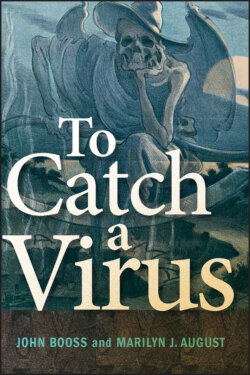To Catch a Virus

Реклама. ООО «ЛитРес», ИНН: 7719571260.
Оглавление
John Booss. To Catch a Virus
Contents
List of Illustrations
Acknowledgments
Foreword
Preface
About the Authors
1. Fear or Terror on Every Countenance: Yellow Fever
Introduction
Germ Theory
Birth of Virology, “Filterable Viruses”
Walter Reed and the Yellow Fever Commission
References
2. Of Mice and Men: Animal Models of Viral Infection
Introduction
Rabies: Dogs and Rabbits
Polio: Monkeys
Arthropod-Borne Diseases, Yellow Fever, and Epidemic Encephalitides: Monkeys and Mice
Influenza: Ferrets
Embryonated Eggs
References
3. Filling the Churchyard with Corpses: Smallpox and the Immune Response
Introduction
Protection: the Case of Smallpox
Start of the Science of Immunology: Phagocytosis and Humoral Immunity
Antiviral Neutralization and Protection
Standardization of Reagents for the First Diagnostic Laboratories
References
4. What Can Be Seen: from Viral Inclusion Bodies to Electron Microscopy
Introduction
Rudolf Virchow and Cellular Pathology
Advances in Light Microscopy
Advances in Tissue Preparation
Rabies—Negri Bodies
Smallpox—Guarnieri Bodies and Elementary Bodies
Varicella—Intranuclear Inclusions and Multinucleated Cells
Cytomegalic Inclusion Disease of the Newborn
The Beginnings of Electron Microscopy and Virological Studies
References
5. The Turning Point: Cytopathic Effect in Tissue Culture
Introduction
The Beginnings of Tissue Culture
Early Applications of Tissue Culture to Viral Growth
FDR . . . “. . . by Friday evening he lost the ability to walk or move his legs . . .”
The Growth of Poliovirus In Vitro: “It was almost an afterthought”
The First Viral Diagnostic Laboratory
The First Diagnostic Virology Laboratory in the U.S. Civilian Sector
References
6. A Torrent of Viral Isolates: the Early Years of Diagnostic Virology
Introduction
Diagnostic Virology in University Hospital Laboratories
The Beginnings of Diagnostic Virology at the CDC
The LID at the NIH
Refinements in Cell Culture Methods and Differential Susceptibility for Viral Diagnosis
Profusion of Isolates, Taxonomy, and the Question of Disease Causation
References
7. Imaging Viruses and Tagging Their Antigens
Introduction. Undefined viral illnesses
Timeliness of diagnosis
Refinements of EM. Early diagnostic EM
Thin sectioning
Shadow casting
Negative staining
Immunoelectron microscopy
Winter vomiting disease
Acute infantile diarrhea
Timeliness of Diagnosis: the Development of FA
Coons and the development of the FA technique
Early viral diagnostic studies with FA techniques
Rapid viral diagnosis: the role of Phillip S. Gardner and Joyce McQuillin at Newcastle-upon-Tyne
References
8. Immunological Memory: Ingenuity and Serendipity
Introduction
Historical Origins of Hepatitis in Catarrhal Jaundice and Homologous Serum Jaundice
Baruch Blumberg, Australia Antigen, and Posttransfusion Hepatitis
Rosalyn Yalow and Solomon Berson: Development of RIA
EIA and ELISA
Western Blots
Immunoglobulin Classes
Monoclonal Antibodies
References
9. To the Barricades: the Molecular Revolution
Introduction
Inheritance, DNA, and the Double Helix
HIV and the AIDS Epidemic
Early Diagnostic Applications of Molecular Nucleic Acid Techniques
PCR and Other Nucleic Acid Amplification Tests
Future Directions for Molecular Diagnostics and Viral Pathogen Discovery
References
Appendix: Chapter Timelines
Index
Отрывок из книги
In tribute to Gueh-Djen (Edith) Hsiung, PhD, who is remembered for her pioneering contributions to the field of diagnostic virology, for training and inspiring generations of diagnostic virologists with her passion for virology, and for her social grace and generosity. (Courtesy of Zhe Zhao.)
Acknowledgments
.....
7 John Zahorsky
8 Norovirus E.M.
.....